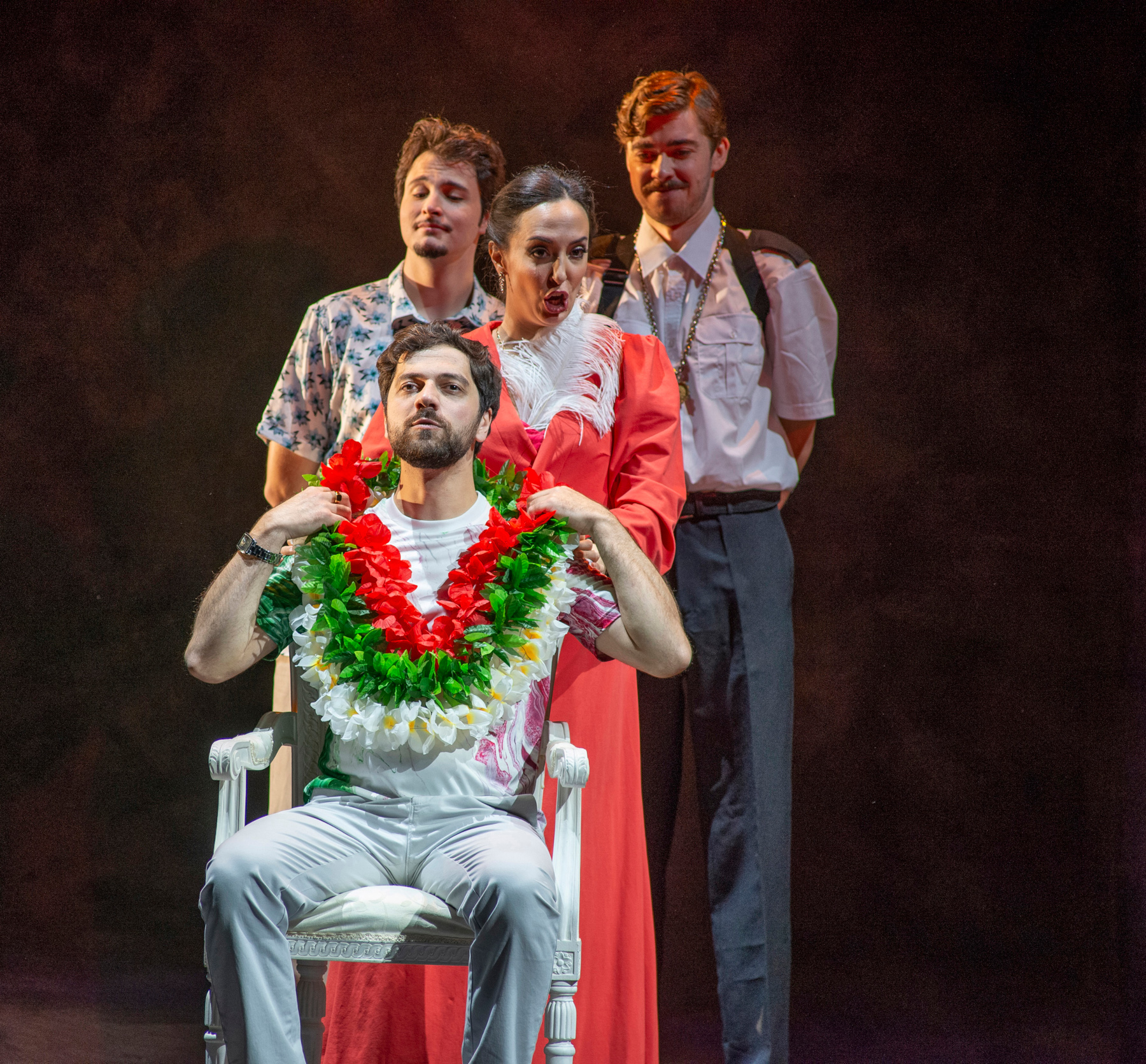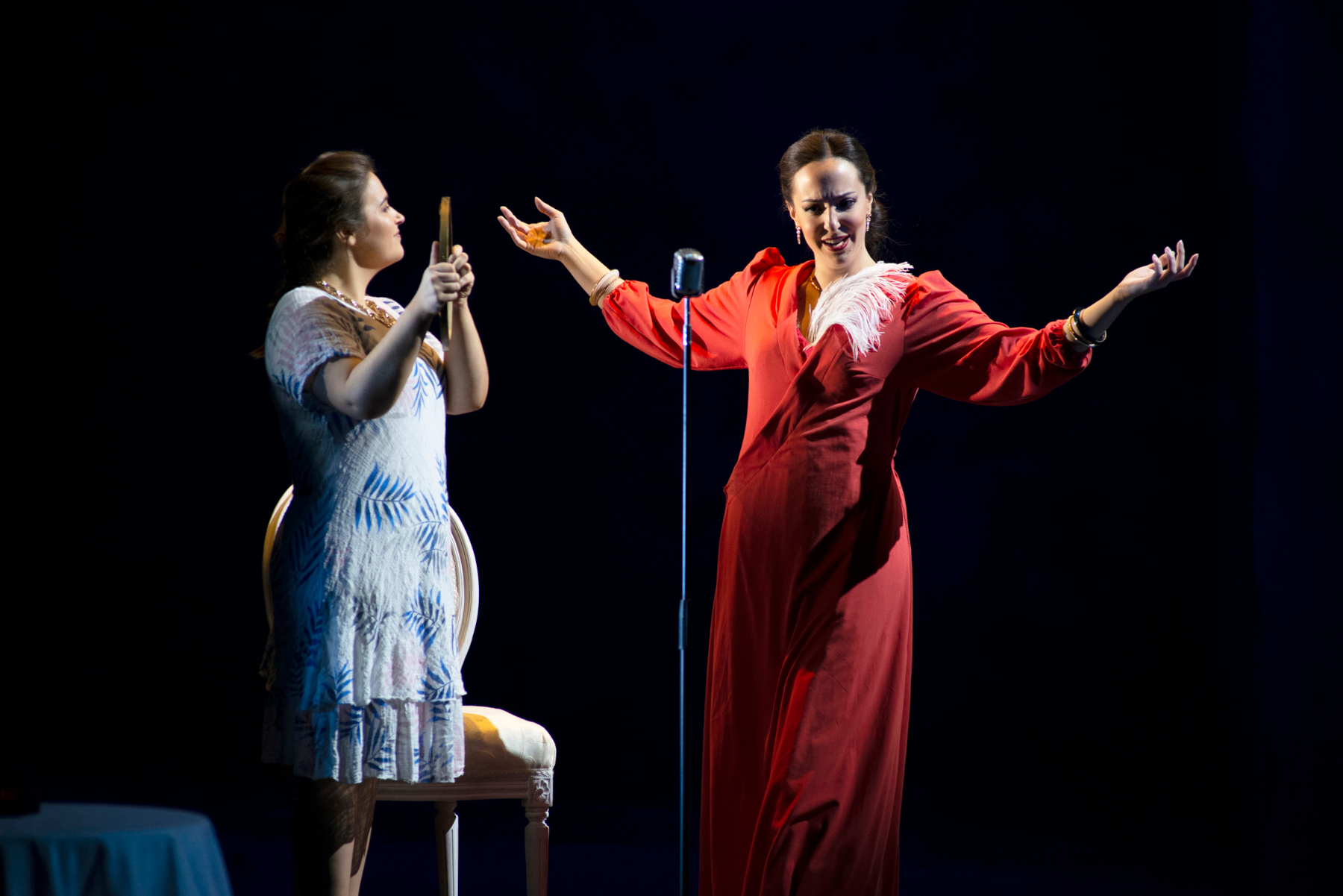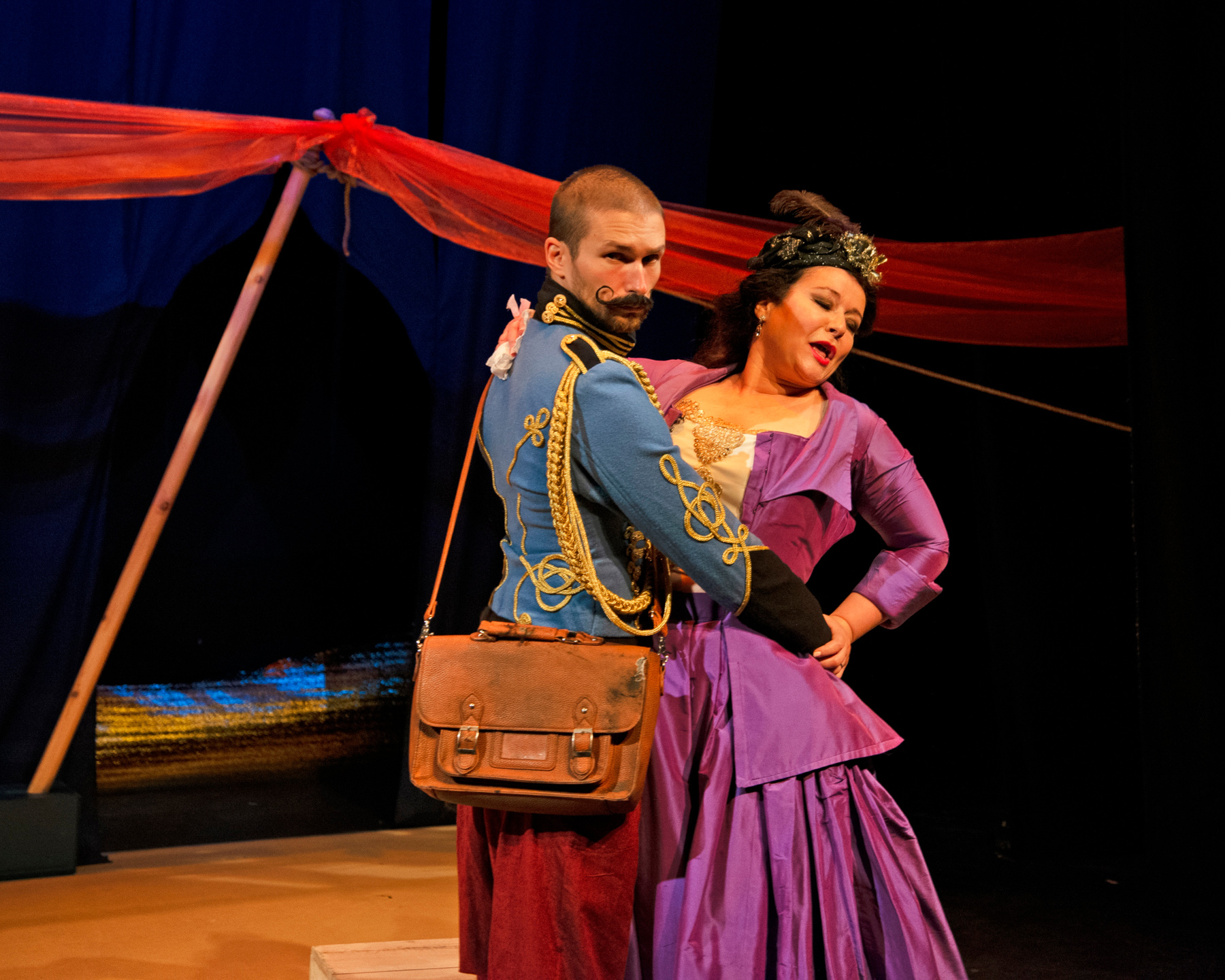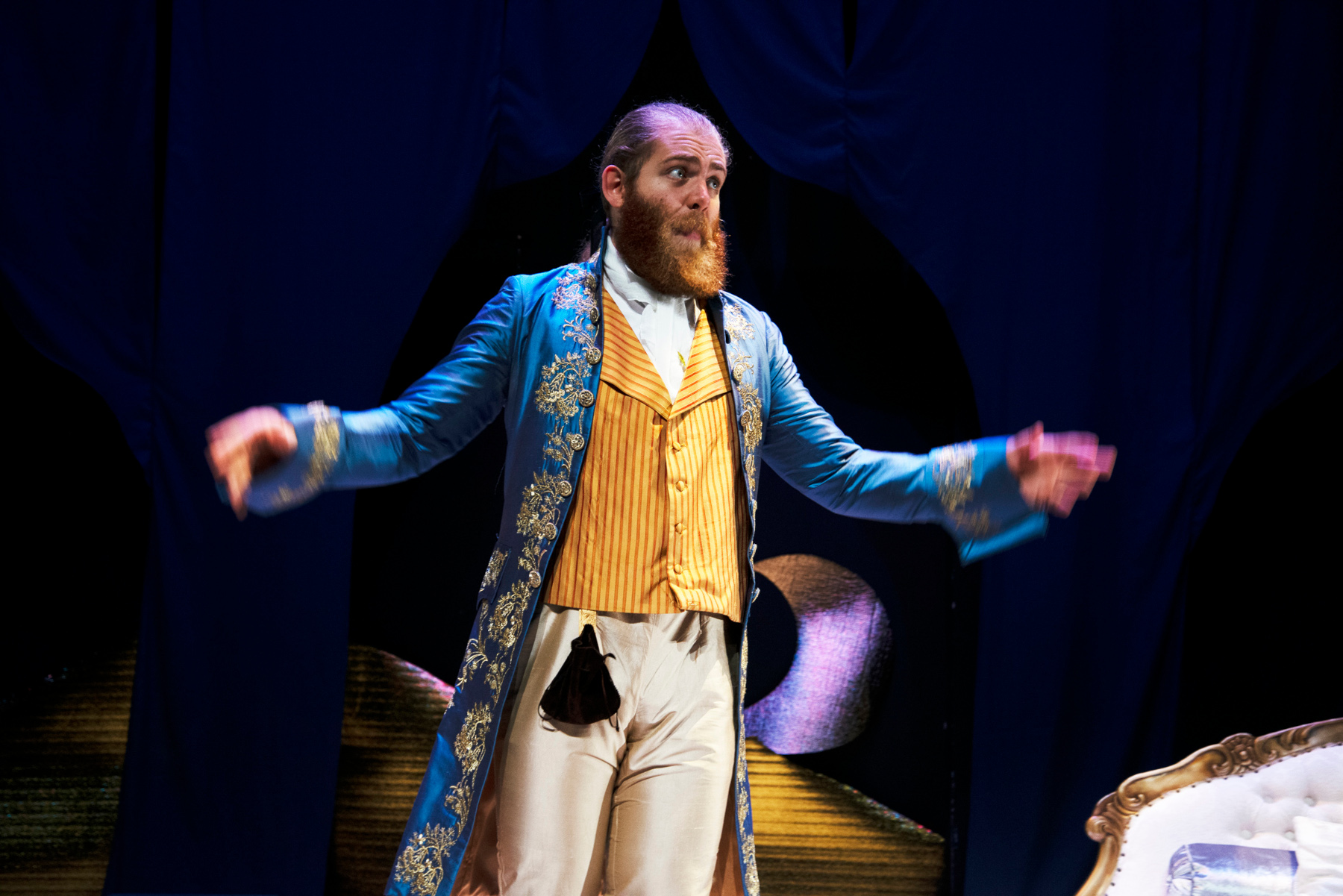If the Wexford Festival’s evening fare in their Women & War themed season is deadly serious, the afternoon offerings were chockful of amusing confections that are more fun than a box of puppies.
In my past experience, these second stage shows featuring talented members of the Opera Factory artistic development program were in found spaces, even after the “new” opera house opened. I saw more than one such production in makeshift places like hotel ballrooms. No more.
Rossini’s L’Italiana in Algieriwas on Wexford’s large Main Stage itself, and Donizetti’s La fille du Regiment was produced in the lovely and intimate Jerome Hynes Theatre in the lower level. Both had the expected excellent, promising talent and admirable production values.
Most Wexford Festival seasons have produced positive talk about one or another “discoveries,” and for me this season it is Giorgi Manoshvili, a refined, and full-voiced bass that was a superlative Mustafà in L’Italiana in Algieri. He had already mightily impressed the night before with a notable performance in Erlanger’s L’Aube rouge.
Mr. Manoshvili not only has an uncommonly large voice that handily fills any house, but also presents a very appealing timbre, easy production, and sound technique that encompasses ravishing legato singing along with virtuosic melismatic execution. Plus, he is tall, handsome, charismatic, and absolutely at ease on the stage, willing to do anything with skill and committed abandon. You read it here: Giorgi Manoshvili is poised to be a sought after star in short order.

While his accomplishment was most notable, there were many other reasons to celebrate this winning Rossini performance.
Isabella is often a star vehicle for ladies with big booming, yet flexible voices, like Marilyn Horne, Stephanie Blythe, and Agnes Baltsa, among others. On this occasion, the voluptuous Marta Pluda proved a slightly gentler approach can also yield big dividends. Her dusky mezzo had impactful presence, and her sound technique resulted in coloratura that was effortlessly executed. Ms. Pluda also understood the guiles and wiles of the character and manipulated the insistent Mustafà with well calculated relish.
The boyish tenor Victor Jiménez Moral made a sturdy contribution with his securely voiced Lindoro. As yet, his is a rather light instrument that can indeed command the stratosphere, but he wisely knows that he doesn’t need to push its delivery, since good focus means his vocalizing is perfectly present in the large house. His youthful playfulness and innate sense of fun are also infectious.
The wiry baritone Eoin Foran is having a field day as the needling Taddeo. His bright, shining vocal delivery was another vocal accomplishment, and his wry joking and consistent animation were highly engaging. Mr. Foran proved an agreeably appealing and musically satisfying colleague in the merriment. Leah Redmond’s Elvira was initially a mixed bag for me, with her slightly fluttery soprano just a bit short on top, and her characterization generalized. Given that this role is the most difficult in which to make an impact, she ultimately won me over with her sass and class, and she warmed to make wonderful contributions to the ensembles. Sarah Luttrel’s assured, straight-froward, and steady mezzo made the underwritten role of Zulma a delight, and Peter Lidbetter’s mellifluent bass brightened the often toss-away role of Haly.
Connor Hanratty did double duty as set designer and director. In his role as the former, Mr. Hanratty espoused the maxim, “simpler is better.” He set the piece in an upscale Algerian hotel lobby that gave way in the second act to the hotel’s supper club. Backed by a parted textured backdrop, and populated by white furniture that was continually, and smoothly re-arranged by the cast, it was all that was required and never seemed on the cheap.

It was good fun that once we moved into the supper club, the bar was fronted by a lightened neon sign that announced: Seraglio. Daniele Naldi’s clever lighting design throughout was a delight. Ditto Francesca White’s evocative costumes. From standard issue hotel employee “drag,“ to tourist regalia, to va-va-voom vamp, to Italian souvenir soccer tee shirts, Ms. White scored a success.
Then there is the asset of Mr. Hanratty’s direction with its clarity, restraint, and inspired clowning. I have seen L’talianain a lot of “important” houses, but I have never enjoyed it more, and laughed more lustily than on this occasion. From the choreographed lunacy to the revelatory plot tricks, to the comedic obsession with visual variants on the Italian flag, I was with you, dude. Mr. Hanratty conceived a fresh and immensely appealing staging.
Musical matters were in good hands with Gioele Muglialdo presiding magisterially in the pit. Giuseppe Monteseano has masterfully arranged an instrumentation for only elven players, and that means there is no hiding place. And none was needed. The band was virtuosic, and even the undersized overture impressed. That Maestro Muglialdo knows his way around this score is never in doubt, but there were a few scrappy seconds of imprecision in the tricky patter passages that were almost instantaneously resolved.
All in all, this was arguably my favorite L‘Italiania theatrical experience in memory. Bravi, tutti!
The Jerome Hynes Theatre is an intimate venue that necessitated a drastic re-thinking of La fille du régiment. Owing to the reduced playing space, the chorus, and all but four of the regiment were eliminated. Thanks to clever staging, carefully selected props and set pieces, and well-considered musical assignments, this worked surprisingly well.

Again almost entirely cast from young artists of the Opera Factory, the title role was very ably encompassed by the pert lyric coloratura, Isabel Garcia Araujo. Her assured singing easily encompassed the rangy challenges Donizetti set out for her. Whether chirping above the staff, plunging to the depths, trilling happily, or melting our hearts with seamless, plangent legato, Ms. Garcia Araujo had the role fully in command. And she’s not only pretty, but also pretty funny, relishing Marie’s comedic tomboyish tendencies. While all sang in the original French, the dialogue was in English, and although Isabel’s speaking was fairly heavily accented, she knew how to make the jokes land.
This show is arguably most famous for the tenor aria with its nine high C’s. The brilliant young singer Chris Mosz not only squarely nailed them, but upped Donizetti one better, and interpolated an extended high D on the penultimate held note. Show-off! (A couple of cries for ‘bis’ – encore – were heard.) Mr. Mosz was an audience favorite, not only for his smooth and sweet-voiced lyric singing, but also for his empathetic teddy bear persona. The world will hear more from, and about him, to be sure.
As Sulpice, James Wafer’s sturdy, manly, ringing baritone had a more pleasant youthful glow and ping than most any other interpreter I have encountered in this role. Mr. Wafer’s stylish presentation, and confident acting were a treat, and a perfect foil for the other characters as they alternately question him, vex him, and seek his help.
Although mezzo Emily Hogarty’s Marquise de Berkenfeld appears young and good-looking enough to be Marie’s sister, she nevertheless makes it all work, first through a convincingly imperious disposition, and second, by vocalizing it beautifully, blessedly free of the oft-encountered “comic” dowager bluster and bombast. Ms. Hogarty’s ample warm, rounded tone was a treat to encounter.

Conversely, although burly baritone Connor Baiano looked butch, his yelping and squealing Horsentius came off as a bit of nelly nonsense in comparison to everyone else, who were more grounded in reality. That was clearly intended, and I did respect his consistency and commitment, and admired his clear, pointed vocalizing. That he was fully aware of his silliness was revealed when he curtsied during his curtain call.
Meilir Jones (Un Caporal) with his refulgent bass and Stephen Walker (Un Paysan) with his burnished baritone provided all the “chorus” that was needed, along with the starchy Duchess of Crackenthorp, Judith be Breiully, who uncharacteristically (for this role) chimed in with a wonderfully modulated mezzo. Michael Conway (Un Notaire) rounded out the diminutive cast in a non-singing appearance.
Lisa Krugel’s set design concept was quite charming, starting out during a brief “overture,” with a flashback of “Marie” as a baby doll in a cradle being rocked and tended to by the soldiers. Poles in the background were festooned with a long draped banner of cloth, and as we came into the present, a few crates were added to the mix as the cradle was struck. When we transitioned to the Marquise’s drawing room, all that was struck to be replaced by a simple white chaise lounge. The piano needed for Marie’s music lesson was already in place down left and was being played with stylistic acumen throughout the show by the accomplished Music Director, Rebecca Warren.
Ms. Krugel also contributed the witty costumes, which ranged from stylish gowns for the elite ladies, a handsome waistcoat ensemble for Hortensius, and fitted uniforms for the guys, with slightly goofy dress up clothes for Marie that compounded her discomfort being in higher society. Maksym Diedov devised some lovely effects with a playful lighting design.
Director Heather Hadrill seamlessly united all this talent into a tidy entertainment package that amused and touched. Her inventive ideas included having the remainder of the soldiers in the unit being represented by aluminum buckets upended and piled in a sculpted mound on a rolling wagon, each topped with a fez. Every time it was rolled on as though the regiment had just marched in proved a good goof.
One suggestion: While the singing was of a natural volume level in that smaller space, the dialogue seemed to be declaimed to be heard by the non-existent top balcony. The readings all connected, but were the volume level halved, it would even out the effect.
Judging by the size of the packed audiences, and hearing the boisterous responses, it looks like the Wexford crowd was not only ready for a good time, but also pleased to sample some standard operatic repertoire. The Opera Factory has emphatically proven to be a great asset to this renowned Irish festival.
James Sohre
L’Italiana in Algieri
Music by Gioachino Rossini
Libretto by Angelo Anellli
Isabella: Marta Pluda; Lindoro: Victor Jiménez Moral; Taddeo: Eoin Foran; Mustafà: Giorgi Manoshvili; Elvira: Leah Redmond; Zulma: Sarah Luttrell; Haly: Peter Lidbetter; Conductor: Gioele Muglialdo; Director and Set Designer: Connor Hanratty; Costume Designer: Frances White; Lighting Design: Daniele Naldi
La fille du régiment
Music by Gaetano Donizetti
Libretto by Jean-François Bayard and Jules-Henri de Saint-Georges
Marie: Isabel Garcia Araujo; Tonio: Chris Mosz; Sergeant Sulpice: James Wafer; La Marquise de Berkenfeld: Emily Hogarty; Hortensius: Connor Baiano; Un Caporal: Meilir Jones; Un Paysan: Stephen Walker; La Duchess de Crackentorp: Judith Le Breuilly; Un Notaire: Michael Conway; Music Director: Rebecca Warren; Stage Director: Heather Hadrill; Set and Costume Designer: Lisa Krugel; Lighting Designer: Maksym Diedov
Top Image: Michael Conway (Actor. Un Notaire), Stephen Walker (Un paysan), Chris Mosz (Tonio), Meilir Jones (Un caporal), Isabel Garcia Araujo (Marie) in La fille du régiment.
All photos by Padraig Grant courtesy of Wexford Festival Opera.